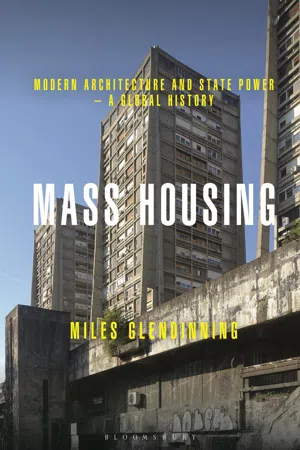
- 688 pages
- English
- ePUB (mobile friendly)
- Available on iOS & Android
About this book
Shortlisted for the Alice Davis Hitchcock Medallion 2021 (The Society of Architectural Historians of Great Britain) "It will become the standard work on the subject." Literary Review This major work provides the first comprehensive history of one of modernism's most defining and controversial architectural legacies: the 20th-century drive to provide 'homes for the people'. Vast programmes of mass housing – high-rise, low-rise, state-funded, and built in the modernist style – became a truly global phenomenon, leaving a legacy which has suffered waves of disillusionment in the West but which is now seeing a dramatic, 21st-century renaissance in the booming, crowded cities of East Asia. Providing a global approach to the history of Modernist mass-housing production, this authoritative study combines architectural history with the broader social, political, cultural aspects of mass housing – particularly the 'mass' politics of power and state-building throughout the 20th century. Exploring the relationship between built form, ideology, and political intervention, it shows how mass housing not only reflected the transnational ideals of the Modernist project, but also became a central legitimizing pillar of nation-states worldwide. In a compelling narrative which likens the spread of mass housing to a 'Hundred Years War' of successive campaigns and retreats, it traces the history around the globe from Europe via the USA, Soviet Union and a network of international outposts, to its ultimate, optimistic resurgence in China and the East – where it asks: Are we facing a new dawn for mass housing, or another 'great housing failure' in the making?
Frequently asked questions
- Essential is ideal for learners and professionals who enjoy exploring a wide range of subjects. Access the Essential Library with 800,000+ trusted titles and best-sellers across business, personal growth, and the humanities. Includes unlimited reading time and Standard Read Aloud voice.
- Complete: Perfect for advanced learners and researchers needing full, unrestricted access. Unlock 1.4M+ books across hundreds of subjects, including academic and specialized titles. The Complete Plan also includes advanced features like Premium Read Aloud and Research Assistant.
Please note we cannot support devices running on iOS 13 and Android 7 or earlier. Learn more about using the app.
Information
PART 1
MID-NINETEENTH CENTURY TO 1945:
THE GATHERING STORM
CHAPTER 1
PRE-1914: THE LONG MOBILIZATION
Introduction
Mid-nineteenth-century innovators and experiments
Table of contents
- Cover
- Title Page
- Contents
- Acknowledgements
- Interviews
- Illustration Credits
- Introduction
- Part 1 Mid-Nineteenth Century to 1945: The Gathering Storm
- 1 Pre-1914: The Long Mobilization
- 2 1914–1945: The Maturing of Mass Housing in the Age of Emergencies
- Part 2 1945–1989: The ‘Three Worlds’ of Postwar Mass Housing
- 3 Postwar Mass Housing: An Introductory Overview
- 4 Housing by Authority: Postwar State Interventions in the ‘Anglosphere’
- 5 Council Powers: Postwar Public Housing in Britain and Ireland
- 6 France: The Trente Glorieuses of Mass Housing
- 7 The Low Countries: Pillars of Modern Mass Housing
- 8 Stability and Continuity: West Germany and the Alpine Countries
- 9 The Nordic Countries: Social versus Individual?
- 10 Southern Europe: Social Housing for Kinship Societies
- 11 The USSR: Developed Socialism and Extensive Urbanism
- 12 A Quarrelsome Family: The European Socialist States
- 13 Socialist Eastern Asia: Mass Housing and the Sino-Soviet Split
- 14 Latin America: Chameleon Continent
- 15 Echoes of Empire: Postwar Housing in the Middle East, South Asia and Africa
- 16 From Third World to First World: Mass Housing in Capitalist Eastern Asia
- Part 3 1989 to the Present: Retrenchment and Renewal
- 17 Resilience and Renewal: Mass Housing into the Twenty-first Century
- 18 Race to the Top: The New Asian Developmentalism
- 19 Conclusion: Global and National, Idealism and Realpolitik
- Notes
- Bibliography
- Index
- Copyright